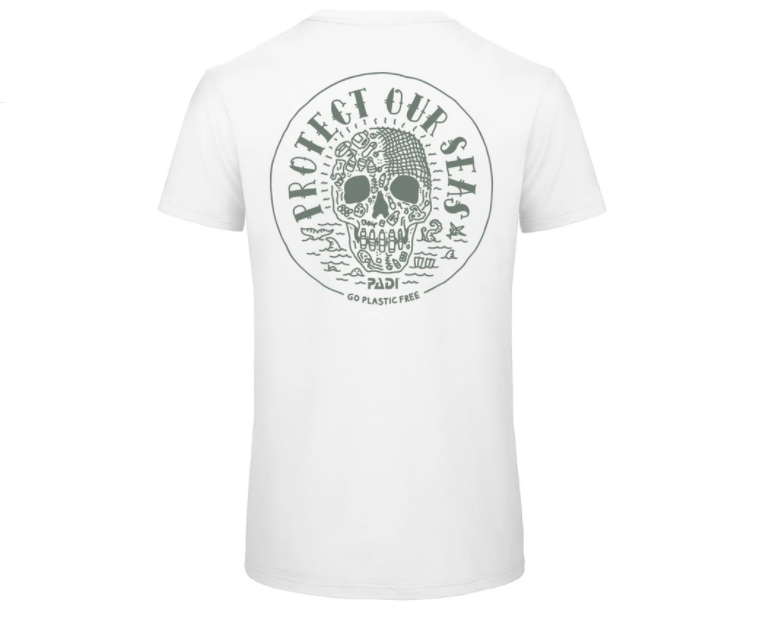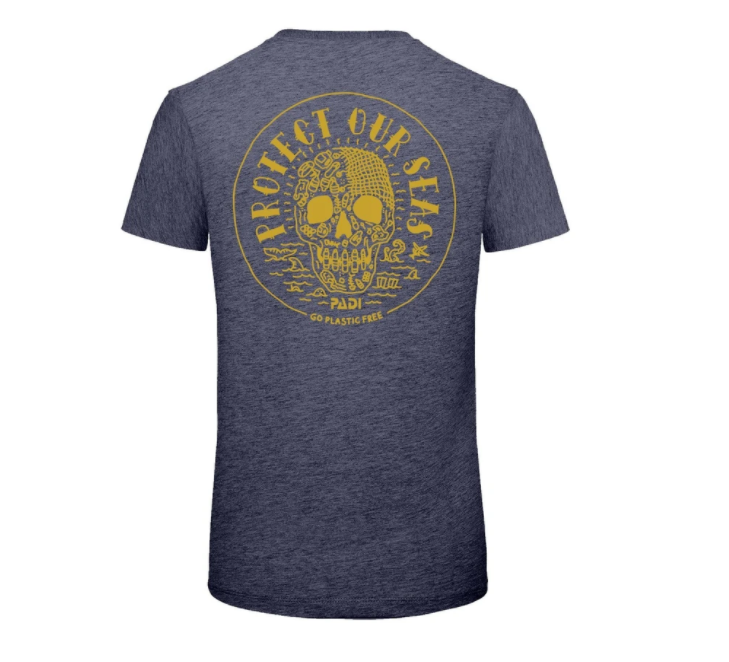 | submitted by /u/buckbuckmow [link] [comments] |
Project AWARE is a nonprofit organisation dedicated to protecting our big blue spaces. #TeamOcean is the passionate fundraisers out there, each doing their bit to help Project AWARE carry out the great work they do. And that’s where you come in…
When you #fundraiseathome for Team Ocean, you take the future of the seas into your own hands. Help us reach our 25K goal for 2020, and have fun simultaneously. It’s called FUNdraising for a reason!
To do your bit for marine conservation, raise awareness, and educate others, here are five fundraising ideas that you could try:
1. Rubbish art

8 million metric tonnes of plastic ends up in the ocean every single year. Why not repurpose some of that plastic into beautiful art? Searches for “ocean trash art” are up +39% on Pinterest this year, so we think people will be into it. You could organise a “build ocean trash art” workshop at a community centre or school and then invite people to come and view your creations for a £3 entry free. All proceeds go towards Project AWARE, and you get to flex your artistic talents in the process, win-win.
2. Ethical is the new black
Did you know? Up to 1,500 gallons of water are needed to grow the cotton for a single pair of jeans. And, the fashion industry is responsible for 10% of humanity’s carbon emissions. This knowledge is an excellent incentive for organising clothes swaps in your local community. You could suggest a £10 entry fee, and everyone gets to walk out with a whole new wardrobe. One woman’s trash is another woman’s treasure! And it feels so much more comfortable to wear when you know it’s ethical.
3. Happy Birthday, Oceans
When your birthday rolls around, do you struggle to think of gifts that you want or need? Why not dedicate your birthday to giving back to the environment? Facebook allows you to create a charity fundraiser. Set one up, send the link to your loved ones, and request that they donate to Project Aware this year instead of buying you another scarf that may end up at the back of a cupboard.
4. Dress down day
People love an excuse to ditch the unflattering office attire or uncomfortable school uniforms. And if it’s for a good cause, how can your boss or teacher say no? Suggest £2 per person, and everyone can come in for a day dressed in their favourite blue themed outfit to honor the sea. This could become an annual event every year on World Ocean Day (8th June), Earth Day (22nd April), or any other environmental days coming up.
5. Get your bake on
You don’t have to be Delia Smith to be able to bake delicious fish-shaped cookies or cupcakes with a little fondant octopus on top. How about setting up a bake sale at your school, office or community centre, with the theme of ocean conservation and selling your delicious creations? Encourage others to bring a stall too, and you’ll be raising money in no time.
For more ideas go to www.projectaware.org/fundraise, where you can also download your Fundraising Action Kit and create your personal or team fundraising profile.
by Adam Hanlon
Night diving offers an opportunity for different subjects and creative techniques for photographers. In this episode of Wetpixel Live, Alex Mustard and Adam Hanlon provide some practical advice about setting up the gear and honing techniques to maximize the potential for striking shots.
Wetpixel Live](http://www.youtube.com/c/Wetpixel-live) is a YouTube channel devoted to short films helping explain the hard-edged information people need to improve their underwater images. To see more of the channel and to be informed about new releases, please head on over to the channel and subscribe.
Reef-World Recognises World’s Most Environmentally Friendly Dive Centres

Rosie Cotton of Tioman Divers, pictured at the 2019 award ceremony (Photo: Reef-World)
DIVE Report
The Reef-World Foundation – international coordinator of the UN Environment Programme’s Green Fins initiative – has announced the winners of its 2020 Green Fins Award.
The annual award recognises the Green Fins member with the lowest environmental impact, with this year’s competition so tight that three dive centres tied for first place: Bubbles Dive Centre and Flora Bay Divers of Pulau Perhentian, Malaysia, and 2019 winners Tioman Dive Centre of Pulau Tioman, also in Malaysia.
The winning dive operators were chosen from the 600-strong network of Green Fins members through a rigorous assessment of their business practices, which had to be undertaken within the last 18 months for the operator to be eligible for the award. Some of the steps taken to improve sustainable practice in order to receive the award include switching to eco-friendly products and improving waste management practices, training staff in why environmental best practice is important, and upgrading boat engines from two- to four-stroke models.
Alvin Chelliah, Green Fins Assessor Trainer from Reef Check Malaysia, said: ‘Most dive centre managers and owners that I have come across in Malaysia care and want to do what they can to help protect coral reefs. I think Green Fins has been the right tool to guide them towards practical actions they can take. Over the years, we have seen these dive centres put in a lot of effort and work hard at following the guidelines and they have improved steadily as a result. We hope others will follow their example.’

The team at bubbles dive centre, receiving their 2020 award remotely (Photo: Reef-World)
Chloe Harvey, Director at The Reef-World Foundation, said: ‘We’re thrilled to recognise Bubbles Dive Centre, Flora Bay Divers and Tioman Dive Centre as joint winners of the 2020 Green Fins Award. Competition between the Top 10 is always tight but the fact that there are three winners this year, when usually one centre takes the title, shows how much sustainability is being put at the forefront of the agenda across the dive industry. So, we’d like to say a big well done to Bubbles Dive Centre, Flora Bay Divers and Tioman Dive Centre. This win is testament to their hard work and ongoing sustainability efforts and they should be very proud. It’s an incredibly tight race to be named the best of the best!’
The Green Fins Top 10 list is comprised of the world’s most sustainable dive operators, as determined by the Green Fins assessment process. The complete list of the 2020 Top 10 is:
- Tioman Dive Centre, Flora Bay Divers and Bubbles Dive Centre (all in Malaysia)
- Ceningan Divers (Indonesia)
- Scuba Junkie Mabul (Malaysia)
- Sea Voice Divers (Malaysia)
- Evolution (Philippines)
- Orca Nation Rawa (Malaysia)
- Equation (Philippines)
- The Barat Perhentian Beach Resort (Malaysia)
For more information on the global Green Fins initiative, visit www.reef-world.org and www.greenfins.net.
Diving into History within St Helena’s South Atlantic Waters

The wreckage of the RFA Darkdale is home to myriad fish, many endemic to St Helena (Photo: St Helena Tourism)
Beneath the warm, clear South Atlantic waters of St Helena, at a depth of around 47 metres, lies the RFA Darkdale – a virtually intact Dale-class tanker of the Royal Fleet Auxiliary (RFA), sunk by a German U-boat not far from Jamestown Harbour during the Second World War. Today, the wreck is teeming with an abundance of marine life, much of it endemic only to the island – and ideally positioned for technical diving.
Launched on 23 July 1940, the 143m-long Darkdale arrived in St Helena in August 1941 as fleet oiler for the South Atlantic, where she sat in port for the next two months servicing a variety of Royal Navy ships that required refuelling during this time, including the HMS Dorsetshire and the aircraft carrier HMS Eagle.

The RFA Darkdale was a Dale-class oiler, identical to its sister ship, the RFA Cedardale (pictured above)
Around midnight on the 22 October 1941, a massive explosion tore through the RFA Darkdale, with a succession of secondary detonations enveloping the ship in flames. The skies above James Bay were lit with orange, the loud sounds of the explosions echoing through the valley in which Jamestown is located. Witnesses still alive today recall the immense tragedy of one of the most monumental events in St Helena’s long maritime history.
The Darkdale had been struck by four torpedoes launched from the German submarine U-68, and was rapidly overcome, capsizing and breaking in two – her stern plummeting to the depths almost immediately and her bow remaining afloat for a short time afterwards.

The hull of the Darkdale remained at the surface for several days following the attack (Photo: St Helena Museum)
Fortyone men lost their lives during the attack. Two were blown clear of the wreck and survived while seven others, including the captain, were on shore leave in Jamestown at the time. Today, they are remembered with a dedicated monument at the seafront in Jamestown, as well as at Tower Hill Memorial in London. The wreck was officially declared a war grave in June 1983.
‘Divers treat the Darkdale shipwreck with the utmost respect, as you are diving through a memorial,’ says Helena Bennett, St Helena’s Tourism Director and diving enthusiast. ‘You realise that a piece of history actually happened here and the horrific nature of that history becomes apparent when you encounter the hull of the Darkdale – spilt by the torpedo. You begin to lose light due to the depth of the dive and are surrounded by the deep, dark blue as the wreck seems to emerge from the shadows and meet you on your descent – quite a chilling experience.’

Larger pelagic hunters are frequently spotted around the wreck (Photo: St Helena Tourism)
Together with its tragic history, exploring the RFA Darkdale encompasses the beauty of shipwreck diving, as you witness the effects of nature on the creations of man. It has attracted an abundance of marine life, often larger than that found around some St Helena’s shallower wrecks. Bullseye, Atlantic jacks and crevalley jacks surround the wreck, with pelagic wahoo and tuna frequently spotted. Several species endemic to St Helena such as the cunningfish, rockfish, greenfish and the plentiful St Helena butterflyfish can be observed up close and in fine detail, having made a home out of heartbreak.
To dive upon the Darkdale is to come face-to-face with a waterlogged moment in time – visit the St Helena Tourism Website to read more about an experience not only for adventurers but also explorers of history.
by Adam Hanlon
We discussed Alex Mustard’s workflow in an episode of Wetpixel Live and in this episode, the spotlight gets turned on Adam Hanlon, who explains the steps of his imaging workflow. He discusses with Alex how he wrangles his images in the field, and how he manages them once he returns home.
It is important to stress that we do not chat about editing specifically. We stress that the best place to get detailed tutorials about editing is Erin Quigley’s site – GoAskErin (https://www.goaskerin.com), and this episode is about the workflow steps not specific editing techniques.
Please subscribe to the Wetpixel Live YouTube Channel. If you do so, you will be automatically notified when we add more episodes covering the things that underwater image makers need to know.
The Power of Giving, Partnerships and Movement Led Conservation Actions for a Clean and Healthy Ocean
By Katie Thompson, PADI Global Director, Corporate Social Responsibility
More than 250 million tons of plastic are estimated to make its way into our ocean by 2025 prompting all of us to ask, how can we tackle this enormous global threat to both human and ocean health in a way that matters?
For almost three decades, divers have been partners in the fight against marine debris, but since 2011, they have taken their actions for a debris free ocean to the next level by recording and reporting to Project AWARE® marine debris found on the sea floor. Divers are adding the unique underwater perspective to this global crisis through the AWARE Dive Against Debris® citizen science program and collecting evidence to inform measures that can stop the problem at source.
How does the Dive Against Debris® program help create long-term change?
Project AWARE works to reduce underwater impacts of marine debris and prevent trash from entering the ocean in the first place.
Project AWARE recognizes the power of the diving community to influence change and document what remains for the larger public out of sight, out of mind. That’s why the flagship citizen science program, Dive Against Debris® was developed – the first and only marine debris survey of its kind focused on scuba divers reporting types and quantities of debris found on the ocean floor. The data reported by Dive Against Debris volunteers, and shared online and offline through AWARE strategic partnerships, helps bridge the gap in knowledge and build convincing arguments to lead to long-term solutions at the policy level.
Can one diver make a difference in the fight against marine debris?
Yes, absolutely. The Dive Against Debris surveys submitted by divers around the world, online or via the dedicated App, into Project AWARE’s global dataset have a cumulative impact. Every survey counts. Some of the major successes of the Dive Against Debris program includes:
- Providing quantitative data, and an accurate perspective about underwater marine debris, that policy-makers simply cannot ignore
- Supporting a global community of debris activists who have reported and aided over 11,289 entangled or dead marine animals
- Building an army of citizen science divers specialized in seafloor debris monitoring and reporting to address data gaps
- Empowering 1,607 Dive Against Debris Instructors who educated over 2,449 students on the threats of marine debris and how to take action to fight it
How does my purchase with PADI support Project AWARE?
When PADI divers, like you, donate to Project AWARE – whether it’s through choosing to receive the PADI AWARE limited edition diver certification card, fundraising or adding a donation to your PADI Gear shopping cart, your donation goes toward protecting what you love: the ocean.
The funds are used by Project AWARE to develop programs and campaigns aimed at educating and engaging the global dive community in ocean conservation actions and courses that lead to change. As a non-profit and civil society, Project AWARE has a seat at the global policy table and works to represent the global voice of the dive community and industry to secure conservation wins that help restore balance between humanity and nature. Donations from individuals and partners, like PADI, are critical to ensuring that the ocean has a voice.
How does Project AWARE and PADI work together to drive conservation outcomes?
Project AWARE and PADI share a rich partnership that spans over 28 years, building a truly unique alliance for protection of the marine environment. To date, with active support from the PADI Community, Project AWARE has driven over 218,000 conservation actions in over 182 countries creating real and measurable impact for the ocean. Major achievements include leading on securing international protection for the most vulnerable shark and ray species and the development of the largest database of seafloor debris in the world.
PADI recognizes that every dive is an opportunity to collect vital data that can be used to create future protection measures for the ocean. We are committed to our ongoing relationship with Project AWARE – our primary partner in marine conservation. With your support, together we will continue to develop new conservation programs and augment existing courses to ensure that we are creating opportunities in which divers can take action. By offering effective pathways to citizen science through activities that preserve underwater habitats and biodiversity vital to human and planetary health, we can help the local communities where we dive.
Together, we are committed to speaking up for the ocean and taking local action for global impact.
Every action, every dive, every donation counts.
Header photo credit: Florian Allgaeuer
Interesting Info
 Private Scuba Tuition – Learn Scuba Skills.
Private Scuba Tuition – Learn Scuba Skills.
Joey Ridge offers private scuba diving training for those who would feel more comfortable in a private one to one setting
Diving Services
- Beginner Diving
- Padi Recreational Courses
- Padi Technical Courses
- Professional Instructor Courses
- Dive Equipment Servicing
Contact Me
Contact: Joey Ridge
PADI Course Director
TecRec Instructor Trainer
Tel: +357 99676216
Whatsapp – Facetime – Skype









